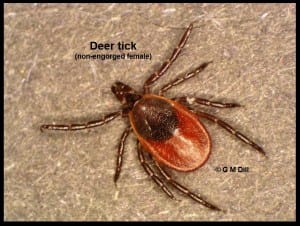By Carol Quish for UConn Extension

The Centers for Disease Control and Prevention (CDC) recommends creating a tick-safe zone. Ticks feed on blood of animals including humans. Tactics to reduce the attractiveness of animals traveling into your yard will keep the number of ticks dropping off of them reduced. Do not feed the birds as chipmunks, squirrels and many other animals visit to eat fallen seeds. Remove leaf litter as a hiding place for small animals and ticks. Clear tall grass and brush from edges of turf and around home. Keep lawn mowed. Keep any wood piles dry and neatly stacked to discourage rodents from using it as a home. Do not place patio or play areas near wooded areas where animals and ticks will be living. Use fencing to keep out deer and larger animals from the yard. Create a 3-foot wide barrier of gravel or wood chips between lawns and woods to stop ticks from entering the lawn. Ticks do not like to cross hot, dry expanses.
Chemical control includes the active ingredient bifenthrin or carbaryl or permethrin or pyrethrin. These are best applied when the ticks are in their small nymphal stage during the month of May and early June. See the CT Tick Management Handbook written by the CT Agricultural Experiment Station for much more detailed information.